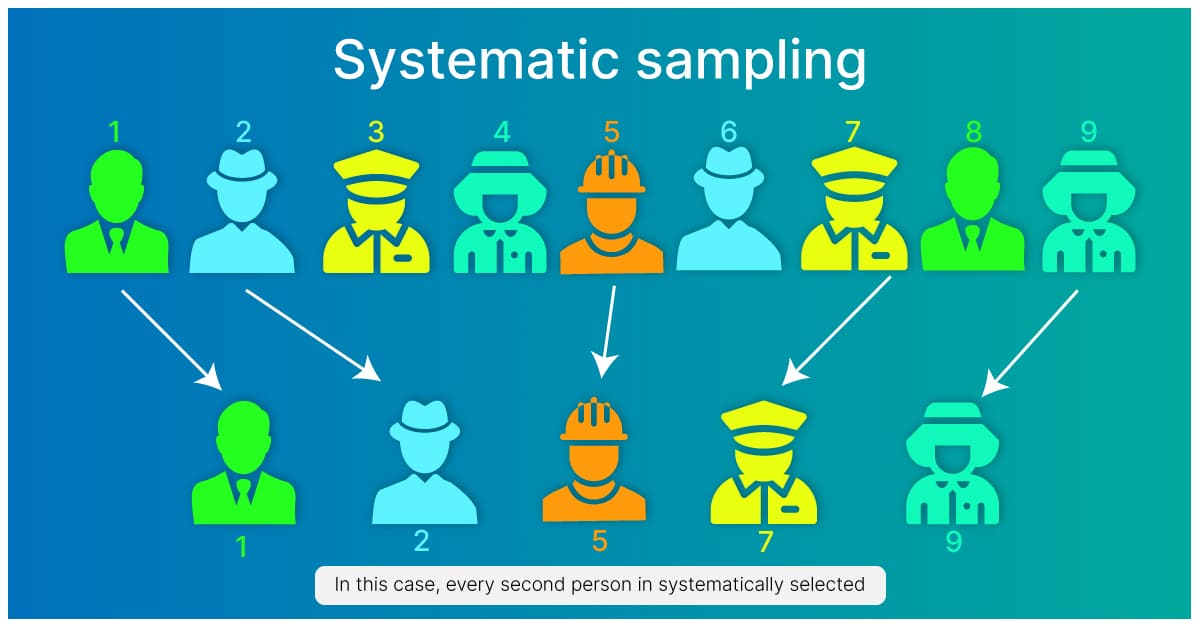A A random sample of 15 students is selected from a class without replacement. Sampling Techniques Multiple Choice Questions and Answers for competitive exams.

Systematic Random Samples Definition Formula Advantages Video Lesson Transcript Study Com
Lastly repeat the sampling interval to choose subsequent elements.
. The non-probability method is a sampling method that involves a collection of feedback based on a researcher or statisticians sample selection capabilities and not on a fixed selection process. In systematic random sampling the researcher randomly selects. Systematic sampling is one way of doing so.
An appropriate sampling interval should be chosen so that the company achieves the desired sample size. First calculate and fix the sampling interval. The first case and every kth case thereafter.
C Systematic random sampling This method involves the formation of a sample in a very systematic manner involves the arrangement of the units in the population in a serial manner. These short objective type questions with answers are very important for Board exams as well as competitive exams. Systematic sampling involves randomly selecting the first item to sample and then selecting subsequent activities at regular intervals.
Like simple random sampling systematic sampling is a type of probability sampling where each element in the population has. The appearance of bunching and seek to avoid it. A Stratified random sampling b Systematic sampling c Cluster or multistage sampling.
A Random samples are easier to select than nonstatistical samples. D Systematic sampling is an example of nonstatistical sampling. B All students in a class are grouped according to their gender.
These short solved questions or quizzes are provided by Gkseries. Which of the following is an advantage of systematic sampling over random number sampling. For example Lucas can give a survey to every.
A Systematic sampling b Stratified random sampling c Simple random sampling d All the above 2Which of the following is an example of a random sam pling method. B Nonstatistical samples can provide useful data. A TwO-stage random sampling b Systematic sampling c Convenience sampling d Purposive sampling.
It is scientific and objective. It removes a significant amount of selection bias. The number of elements in the population divided by the number of elements needed for the sample Choose a random starting point between 1 and the sampling interval.
Your first selected unit is r. Orton 2000 notes that one disadvantage with systematic. C Stratified random sampling involves breaking the population down into geographic subgroups.
It is expensive and time consuming to locate the sample. Every 10th or 20th name for example is selected from the sampling frame. Systematic random sampling requires the user to order the population units in some fashion randomly select one unit from among the first k ordered units and then select subsequent units by taking every kth ordered unit.
Below are the example steps to set up a systematic random sample. Cases following any systematic pattern. In most situations the output of a survey conducted with a non-probable sample leads to skewed.
A Stratified random sampling In this method the universe or the entire population is divided into strata ie a number of homogenous groups. A major point to be kept in mind here is that the population should be finite in nature and also should be defined very clearly. 1SIMPLE RANDOM SAMPLING -In statistics a simple random sample is a subset of individuals chosen from a larger set in which a subset of individuals are chosen randomly all with the same probabilityIn srs each subset of k individuals has the same probability of being chosen for the sample as any other subset of k individuals.
136 Which of the following statements is true. For example you can choose every 5th person to be in the sample. It provides a stronger basis for statistical conclusions.
1Which of the following is not an example of a random sampling method. There is still a chance that the sample can be unrepresentative. Stratified random sampling is a method of sampling that involves dividing a population into smaller groupscalled strata.
A random sample of 8 is selected from the males and a separate random sample of 7 is drawn from the females. Cluster sampling often involves selecting. In the population is a higher priority that a strictly random sample then it might be appropriate to choose samples nonrandomly.
In selecting a sample of n units from a population of N units when Nnk using a systematic sampling approach we follow the following steps. It enables the auditor to use the more efficient sampling with replacement tables. Which of the following yields a systematic sample.
Q1 Briefly explain the following methodstechniques of restricted random. Systematic sampling is an extended implementation of the same old probability technique in which each member of the group is selected at regular periods to form a sample. Systematic random sampling is the random sampling method that requires selecting samples based on a system of intervals in a numbered population.
Systematic Sampling is when you choose every nth individual to be a part of the sample. List the units giving a serial number from 1 to N. Select a random number between 1 and k Say this is r.
The groups or strata are organized based on the shared characteristics. Determine the sampling interval k dividing TV by k Nn.

Four Types Of Random Sampling Techniques Explained With Visuals By Terence Shin Towards Data Science

0 Comments